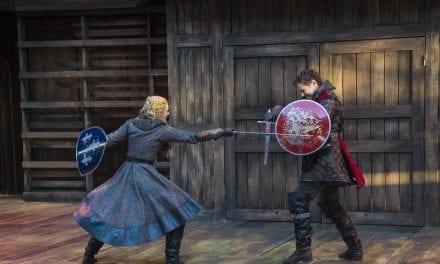LEHI — On Friday evening I had a flashback to two different Christmases. No, I wasn’t playing Scrooge in a production of A Christmas Carol. Instead, I was reminded of playing a shepherd in a church Christmas pageant when I was about ten years old. I also remembered my younger brother playing Joseph when he was roughly the same age. I had these pleasant memories come back to me while at the Lehi Arts Center while watching a production of The Best Christmas Pageant Ever.

Show closes December 17, 2012.
The Best Christmas Pageant Ever is about a small-town church Christmas pageant in the 1940’s or 1950’s, which is the same every year. This year, however, Mrs. Armstrong, the usual pageant director, is confined to a hospital and the task of directing the dozens of children to tell the Nativity story falls on Grace Bradley. Grace’s task doesn’t seem too difficult until the six Herdman children—the wild troublemakers of the town—show up and want to be part of the pageant. What looks like an impending disaster actually turns out to be what the title describes: The Best Christmas Pageant Ever. (Normally I wouldn’t give away the ending in a synopsis, but the title already does that.)
The core of the story is the Bradley family. The play is narrated by Beth Bradley (played by Lily Elison), the daughter in the family. Elison did an excellent job moving the story along, and was never slow with any of her cues. Elison also had a nice relationship with her stage brother, James Albrecht, who played Charlie Bradley. Both children seemed very comfortable on stage, and understood how to act around a bully and what it’s like to be embarrassed by their parents. Wendy Belcher was a warm mother to these two children and excellent as the center of a small town drama. Belcher was stellar in portraying the stress of managing about two dozen rowdy children while under great social pressure. I especially loved the rehearsal scene where she gradually lost control of the kids.
Losing control of the kids is what real-life director Julie Dever did not do. I was surprised in the first scene, with all of the children, that there were so many young people in the cast. I thought—incorrectly—that such a large number of kids would have been noisy backstage during an exciting opening night. The children were also (mostly) focusing their attention on where they should be on stage, and very few of them seemed like they were bored of watching the same scenes again and again.
As for the visual style of the play, the costumes (uncredited in the program) for the adults were excellent in creating the mood of the simpler time and place in which the story takes place. The telephone scenes were especially pleasing because of the 1950’s housewife costumes that each woman wore, all of which would have looked in place in an episode of I Love Lucy. I also liked the set (designed by Jerry Hatch) because its simplicity reflected the simple nature of Barbara Robinson’s script. However, I wish some of the scene changes were faster. But this isn’t a huge problem, since the show ran just over one hour long even with a few slow scene changes.
On the other hand, this show is a little rough around the edges in almost every aspect. But for The Best Christmas Pageant Ever, this is acceptable because children’s church Christmas pageants themselves are a little rough. In fact, in the pageant scene itself I found it a little endearing when a child scratched their nose or shifted their weight; these things are exactly what someone should expect when watching a nativity pageant. The closet costuming also seems appropriate for this type of production, although it wouldn’t win any awards.
Lehi Arts Council’s The Best Christmas Pageant Ever is sweet, and it brings a genuine Christmas spirit. Although I had never seen the show before, I found the script predictable but comforting. Lehi Arts Council’s production brought a genuine Christmas spirit to my weekend, especially when the audience was invited to sing “Silent Night.” Like a Christmas pageant, this play isn’t supposed to be a highly polished overdesigned show; but it still accomplishes its goals by reminding its audience about the entire purpose of the Christmas holiday.




